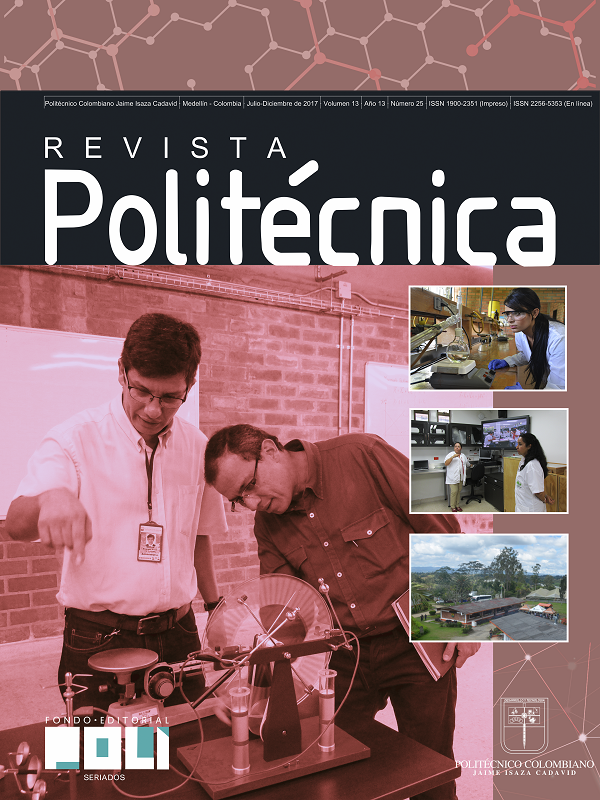Caracterización de marcadores de realidad aumentada para su uso en robótica
DOI:
https://doi.org/10.33571/rpolitec.v13n25a7Palabras clave:
Visión por computador, Realidad Aumentada, Marcadores, Robótica, Robot móvilResumen
Pese a la amplia variedad de estudios e investigaciones en realidad aumentada aplicada en sistemas robóticos, en general no se aprecia un análisis del cómo afecta a la detección de los marcadores: la iluminación, las distancias, ni los ángulos de incidencia de la cámara de los robots, menospreciando la importancia de estos parámetros en la representación de objetos aumentados, por lo cual se dificulta hacer una comparación más objetiva del desempeño de las aplicaciones de realidad aumentada en los robots. Este articulo describe un procedimiento para analizar un conjunto de marcadores estándar de realidad aumentada teniendo en cuenta distancias, ángulos de detección e iluminación, al igual que el efecto del tamaño del marcador en la escala de los objetos aumentados, de forma que ayuden al lector a determinar que efecto tienen sobre el desempeño del sistema, y planteando una serie de recomendaciones originadas en los resultados de pruebas técnicas con el fin de mantener una detección óptima de los marcadores en ambientes in-door.
Métricas de artículo
Resumen: 1911 HTML: 1134 PDF: 689 XML: 41Métricas PlumX
Citas
Krevelen, V. & Poelman, R. (2010). A Survey of
Augmented Reality Technologies, Applications and Limitations. The International Journal of Virtual Reality, 9(2), 1–20.
I. Y. Chen, B. MacDonald, and B. Wunsche, “Mixed Reality Simulation for Mobile Robots,” Robot. Autom. 2009. ICRA ’09. IEEE Int. Conf., pp. 232–237, 2009.
Kevin Sebastian Kain, Susanne Stadler, Manuel Giuliani, Nicole Mirnig, Gerald Stollnberger, and Manfred Tscheligi. 2017. Tablet-Based Augmented Reality in the Factory: Influence of Knowledge in Computer Programming on Robot Teaching Tasks. In Proceedings of the Companion of the 2017 ACM/IEEE International Conference on Human-Robot Interaction (HRI '17). ACM, New York, NY, USA, 151-152.
Kozlov, et al. (2007). Towards Improving SLAM Algorithm Development using Augmented Reality. Proceedings of Australasian Conference on Robotics and Automation (ACRA) 2007, 7–17.
Luo, R. C. & Lai, C. C. (2014). Multisensor Fusion-Based Concurrent Environment Mapping and Moving Object Detection for Intelligent Service Robotics. IEEE Transactions on Industrial Electronics, 61(8), 4043–4051.
B. Yen-Hung Chen, Ian; MacDonal, Bruce; Wunsche, “Markerless Augmented Reality for RoboticHelicoptor Applications.,” Robot Vision, Lect. Notes Comput. Sci., vol. 4931, pp. 125–138, 2008.
J. BędkowskiMas and A. Masłowski, “Augmented reality approach for mobile multi- robotic system development and integration,” Tech. Komputerowe, vol. 1, pp. 15–24, 2009.
J. Carff, M. Johnson, E. M. El-Sheikh, and J. E. Pratt, “Human-robot team navigation in visually complex environments,” 2009 IEEE/RSJ Int. Conf. Intell. Robot. Syst. IROS 2009, pp. 3043–3050, 2009.
Mekni, M. & Lemieux, A. (2014). Augmented Reality : Applications , Challenges and Future Trends. Applied Computational Science Anywhere, 205–214.
S. Makris et al, "Augmented reality system for operator support in human–robot collaborative assembly". CIRP Annals - Manufacturing Technology, Ed: Elsevier, Volume 65, Issue 1, 2016, Pages 61-64
Bunz, E., Chadalavada, R T., Andreasson, H., Krug, R., Schindler, M. et al. (2016) Spatial Augmented Reality and Eye Tracking for Evaluating Human Robot Interaction. In: Proceedings of RO-MAN 2016 Workshop: Workshop on Communicating Intentions in Human-Robot Interaction
J. Mejía Bustamante and R. López Varona, “Calibración de Cámara Termográfica Fluke TI-32 Thermographic camera calibration FLUKE TI-32,” Sci. Tech. Año XIX, vol. 19, no. 1, pp. 59–66, 2014.
A. I. Barranco, S. Martínez Díaz, and Gómez.Jose, Visión Estereoscópica Por Computadora Con Matlab Y Opencv, 1st ed. Hardcover (dust-jacket), 2010.
A. Fetić and D. Jurić, “The procedure of a camera calibration using Camera Calibration Toolbox for MATLAB,” MIPRO, 2012 Proc. 35th Int. Conv., pp. 1752–1757, 2012.


 _
_






















